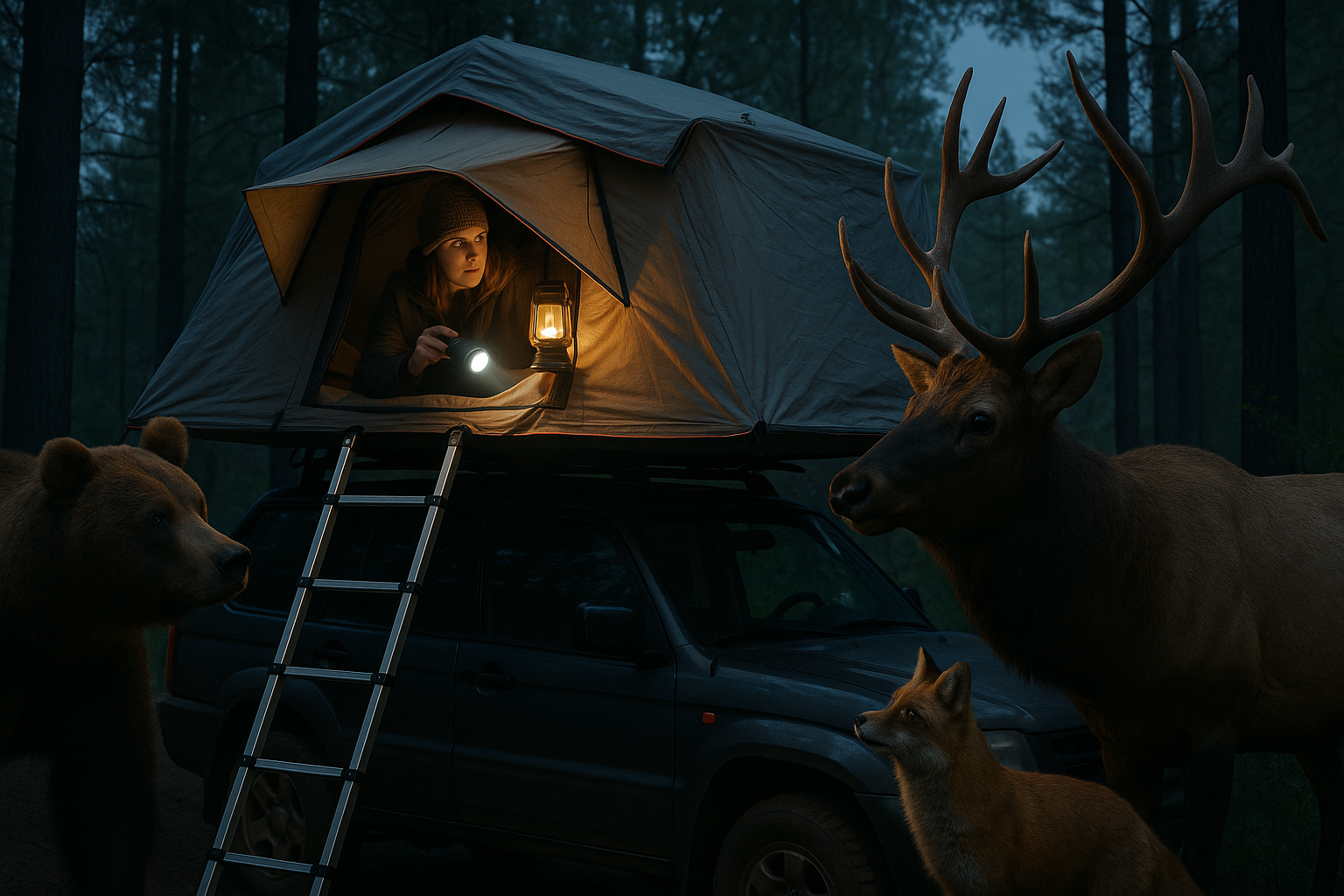It’s late, the campfire’s down to embers, and you’re drifting off in your rooftop tent—until you hear the unmistakable rustle of paws, wings, or hooves nearby. Whether it’s a curious raccoon, a stealthy fox, or an unexpected bear, uninvited wildlife guests can turn a peaceful night into a survival challenge. And when you’re camping in a rooftop tent, your options are limited. Forget the generic “hang your food” advice—here are real, field-tested tactics to fortify your rooftop setup against animal intrusions.
1️⃣ Perimeter Defense: Scent and Sound Barriers
Animals follow their nose and ears. Disrupt these cues:
- Scatter pungent deterrents like coffee grounds, vinegar-soaked cloth, or citrus peels around your vehicle and ladder base. These strong scents disrupt animal scent trails.
- Hang portable wind chimes, carabiners, or even a can filled with rocks from branches or tent edges. The irregular clinking sounds deter curious animals from approaching.
- Smear a mix of vinegar and natural oils (peppermint, tea tree) around ladder steps—especially effective against raccoons and rodents.
🛠 Why it works: Most animals avoid unfamiliar or overpowering scents and sounds that hint at human presence or danger.
2️⃣ Ladder Lockdown: Fortify Access Points
Rooftop tents are elevated, but determined climbers—like raccoons or snakes—can scale ladders:
- Remove the ladder entirely when not in use, especially overnight.
- If removal isn’t possible, wrap the ladder base with smooth plastic sheeting or a garbage bag, secured with tape. This creates a slick surface that’s difficult for animals to grip.
- For a stealth barrier, coat the ladder with biodegradable soap or wax, making it slippery but environmentally safe.
🛠 Why it works: Without a stable climb, most animals won’t risk the effort to reach your tent.
3️⃣ Bright Barrier: Light as a Deterrent
While rooftop tents need low visibility for human stealth, strategic light can repel wildlife:
- Set up a motion-activated light (a small solar-powered one works well) near the ladder or vehicle. Animals startled by sudden light often retreat.
- If you lack gear, hang glow sticks or snap bracelets around the base of your tent or ladder—these glow brightly and confuse nocturnal creatures.
- String fairy lights (battery-operated) around the vehicle perimeter for a low-energy, continuous deterrent.
🛠 Why it works: Sudden or unusual light breaks an animal’s approach instinct, making them think a predator or human is nearby.
4️⃣ Noise Defense: Controlled Disruption
Instead of blasting a radio, use targeted noise to keep animals at bay:
- Tie a few metal spoons or forks to a line that moves slightly in the wind. The clatter is subtle but enough to deter many critters.
- Shake a water bottle with coins or pebbles occasionally if you hear movement nearby.
🛠 Why it works: Animals fear irregular, non-natural sounds that might indicate a threat.
5️⃣ DIY Animal Repellent Spray
Create a natural repellent using campsite supplies:
- Mix vinegar, crushed garlic, and hot pepper flakes with water. Let it steep and spray around your vehicle base and ladder.
- If garlic isn’t available, substitute with lemon juice and essential oils (eucalyptus, peppermint).
🛠 Why it works: The strong scent combination masks food smells and deters animals from approaching.
6️⃣ Food Storage: Think Beyond the Obvious
While rooftop tents keep you off the ground, scent attracts wildlife:
- Seal all food and trash in double-bagged, airtight containers—don’t rely on standard dry bags or coolers.
- Use odor-proof pouches or bags for storing snacks and waste.
- Cook at least 50 yards away from your rooftop setup to disperse cooking smells.
🛠 Why it works: Even trace food scents can lure animals to your tent, especially in areas with habituated wildlife.
7️⃣ Footprint Control: Erase Human Traces
Before settling in:
- Scatter fresh soil or leaves over footprints and disturbed ground near your tent. This disguises human scent trails.
- Rinse off cooking gear immediately to prevent residual food smells from lingering.
🛠 Why it works: Erasing scent and visual cues reduces the chance of animal curiosity.
8️⃣ Defensive Perimeter: Natural and Improvised Barriers
If you’re in a pinch:
- Lay a circle of thorny branches, rocks, or firewood around the ladder base. This creates a physical obstacle for animals.
- Use pinecones or even cacti segments if available—they’re uncomfortable for paws and deter climbing.
- For stealth defense, scatter pepper powder or sand infused with essential oils around the perimeter.
🛠 Why it works: Physical obstacles confuse animals and slow their approach, giving you time to react.
9️⃣ Monitor and React: Low-Tech Alerts
Stay aware without fancy gear:
- Tie a string with bells, carabiners, or bottle caps around your tent or ladder. When disturbed, it provides an audible alert.
- Use a small mirror or shiny object positioned to catch movement near your ladder base.
🛠 Why it works: Early detection lets you react before an animal makes it to your tent.
Real-World Camper Tips:
🔹 “I once used a line of pinecones around my ladder—it kept raccoons away all night.”
🔹 “A simple glowstick bracelet was enough to keep foxes from sniffing around the base of my tent.”
🔹 “Soaked coffee grounds made my car perimeter smell awful to wildlife, but it worked.”
Conclusion:
Unexpected animal visitors can turn a peaceful night in your rooftop tent into a survival scenario. But with smart, field-tested tactics—from scent disruption to physical barriers—you can protect your camp without relying on bulky gear or high-tech gadgets. Whether it’s a slick ladder, a natural repellent spray, or makeshift noise alerts, these strategies keep you in control and wildlife at bay.
🌙 Stay alert, stay secure—and let the wild ones know you’re not on the menu.

